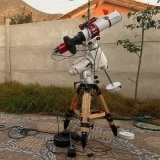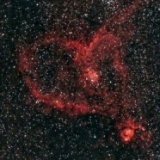INDI Library v2.0.7 is Released (01 Apr 2024)
Bi-monthly release with minor bug fixes and improvements
ThankStellarMate/EKOS - EQM-35 Pro guiding issues (brilliant start but then...)
- Nico Augustin
-
 Topic Author
Topic Author
- Offline
- Senior Member
-

- Posts: 48
- Thank you received: 8
StellarMate/EKOS - EQM-35 Pro guiding issues (brilliant start but then...) was created by Nico Augustin
I tried to find solutions in the forum but arrived at the end of my knowledge or rather out of ideas what to try next...
I´m running a EQM-35 Pro mount via WiFi remoted StellarMate (RasPi 3). Main camera is a ASI294MC Pro and guide camera is a QHY 5L-IIc. All cameras and scope configurations are loaded fine and all gear is reacting as it should be. The mount is connected via the StellarMAte and I have no ST4 cable connected and use pulse guiding. Polar alignment was made with the EKOS alignment tool. After slewing and plate solving to my target, I see some good guide stars in the QHY 5L-IIc frames (gain 8-10, 2 sec, 2x2 bin) but I have some issues with the reliability of the guiding. Maybe someone here faced similar or comparable issues and can give some advice.
After running the calibration and guiding started it looks all very good. Guiding in both axes is "spot on" with very little corrections made. So basically the moment you would smile, start imaging and lean back.
However, after a little while and out of the sudden the guiding is completely off, the little dots in the drift plot jump from the green/center area right into the yellow or even red and it takes a little while in recovering from that. The images of course get double stars or trails.
I tried many many different settings but nothing really stopped this behavior. Sometimes the message comes up saying "Delta RMS threshold value exceeded" - what I tried to google but could not really find any explanation. Then a new star gets picked (even if I deactivated Auto Star) annd guiding continues well for a wile again. Same problem often occurs after dithering quite often so that I have to stop guiding manually and just restart).
I have the feeling it maybe has something to do with the way the guide star but my options are limited. I tried to play with the camera settings to get better stars (gain, darks) and the box sizes but that did not solve it. Also it seems to be unpredictable - sometimes its fine for 10-15 min including dithering, and then it´s just good for a couple of minutes. Also tried alternatively the SEP algotythm instead of SMART but in general that made no difference.
The gude module main settings I´m using are:
Exposure 2s
Bin 2x2
Box 32 (tried 16 and 64 too)
Guiding Rate 0.5 (tried 1.0 too)
Calibration I do with Pulse 3000, Iterations 3 (with lower pulse the DEC calibration fails)
Guide settings:
Algorithm SMART or SEP (not much difference seen)
Lost Star Timeout 60 s
Max Delta RMS 10.00 arc sec (tried 15 arc sec too but did not change on the problem)
Dither 2.5 pixels
Frequency 1-3 frames
Threshold 2 pixels
Settle 20 s
Timeout 180 s
Max Iterations 10
Control Parameters (next to the drift plot) are on default:
Proportional gain 133.3/133.3
Integral gain 0.0/0.0
Maximum pulse 5000/5000
Minimum pulse 100/100
I would be happy about any ideas what to do/try.
One idea is to alternatively try PHD2 guiding once and see if the same behavior comes up - but I rather like to use the internal guider.
I have a second setup with a CEM25P and a (non remotely controlled) RasPi 4 and StellarMate OS. There I dont face any guiding problems at all. Guiding and dithering runs stable for hours. This new EQM-35 Pro slightly drives me nuts...
Thanks in advance!
Nico
Please Log in or Create an account to join the conversation.
- Jasem Mutlaq
-

- Offline
- Administrator
-

Replied by Jasem Mutlaq on topic StellarMate/EKOS - EQM-35 Pro guiding issues (brilliant start but then...)
I would give PHD2 a go just to find if the issue is indeed in Ekos or elsewhere. Most of the troubleshooting done is a game of elimination. The fact that you communicate with the mount via WiFi could also be the issue, maybe the pulses don't arrive just fast/reliable enough?
Also turning on Guide logging and sharing the log might be helpful.
Please Log in or Create an account to join the conversation.
- Nico Augustin
-
 Topic Author
Topic Author
- Offline
- Senior Member
-

- Posts: 48
- Thank you received: 8
Replied by Nico Augustin on topic StellarMate/EKOS - EQM-35 Pro guiding issues (brilliant start but then...)
Will report as soon as I have any new info.
Please Log in or Create an account to join the conversation.
- Jasem Mutlaq
-

- Offline
- Administrator
-

Replied by Jasem Mutlaq on topic StellarMate/EKOS - EQM-35 Pro guiding issues (brilliant start but then...)
Please Log in or Create an account to join the conversation.
- Wouter van Reeven
-

- Offline
- Supernova Explorer
-

- Posts: 1957
- Thank you received: 420
Replied by Wouter van Reeven on topic StellarMate/EKOS - EQM-35 Pro guiding issues (brilliant start but then...)
Perhaps first guide with dithering disabled and see if the guide RMS values start jumping around again.
Wouter
Please Log in or Create an account to join the conversation.
- Nico Augustin
-
 Topic Author
Topic Author
- Offline
- Senior Member
-

- Posts: 48
- Thank you received: 8
Replied by Nico Augustin on topic StellarMate/EKOS - EQM-35 Pro guiding issues (brilliant start but then...)
Please Log in or Create an account to join the conversation.
- Nico Augustin
-
 Topic Author
Topic Author
- Offline
- Senior Member
-

- Posts: 48
- Thank you received: 8
Replied by Nico Augustin on topic StellarMate/EKOS - EQM-35 Pro guiding issues (brilliant start but then...)
I read in the CloudyNights forum that there would be the one or other way to work around this issue (as duiding the DEC axis only in one direction and do only RA dithering) so, maybe I can try this within EKOS? I don´t think that it´s needed to open the mount directly (would not know what to do anyway) but I will also inform my vendor about this because I still have warranty on the mount
Maybe you are seeing something else in the Log that maybe would help to improve it?
Best, Nico
Please Log in or Create an account to join the conversation.
- Nico Augustin
-
 Topic Author
Topic Author
- Offline
- Senior Member
-

- Posts: 48
- Thank you received: 8
Replied by Nico Augustin on topic StellarMate/EKOS - EQM-35 Pro guiding issues (brilliant start but then...)
did you have a chance to look into the guide logs? I tried to do DEC guiding in only one direction last night (forgot to record a log though). The guide graph and drift plot looked super perfect. However, suddenly the "Delta RMS threshold value exceeded" thing came up again. It visualizes as follow: in the drift plot all points are in the "green zone", nicely close together, and beeing corrected slightly towards the center if necessary. Then, out of the sudden the plot blinks white because it thinks the guide star jumped out of the box... In fact the guide start still sits nicely in the box in the captured frame from the guide cam. The response of the Guiding module is to try to correct that until the "Delta RMS threshold value exceeded" message comes, a new gude star is choosen and guiding continues. Also, it´s not reproducable since this comes either once in a while or with every second image... sometimes after dithering sometimes within normal imaging.
Any thoughts on settings I could still try? Any way I can tell Ekos to not overreact?
Alternatively, is there a way to stop/restart imaging when this happens? When I see it happen now I simply stop guiding (imaging is stoped automatically) and then start guiding and imaging manually. If that could be automated it would help at least a little (to calm down and not looking all the time on the guiding screen
Oh, one more thought - since I´m using a QHY 5L-IIc under Bortle 7 skies with a relatively high gain (activated dark), could it have something to do with the image quality of the guiding cam?
Please Log in or Create an account to join the conversation.
- Nico Augustin
-
 Topic Author
Topic Author
- Offline
- Senior Member
-

- Posts: 48
- Thank you received: 8
Replied by Nico Augustin on topic StellarMate/EKOS - EQM-35 Pro guiding issues (brilliant start but then...)
This is the message that comes in the Log when it wents wrong:
- m_starLostCounter 0 m_highRMSCounter 12 delta_rms 15.3922 (this number varies between 11.x and 79.x)
- "Delta RMS threshold value exceeded. Searching for guide stars..."
- Capturing frame...
- Reading FITS file buffer
- Received guide frame.
- "Autoguiding started."
Any ideas how to prevent loosing the guide star?
Please Log in or Create an account to join the conversation.
- Jasem Mutlaq
-

- Offline
- Administrator
-

Replied by Jasem Mutlaq on topic StellarMate/EKOS - EQM-35 Pro guiding issues (brilliant start but then...)
You can increase max delta RMS to 30 arcsecs in Guide options, but that would be putting a temporary bandage on the issue. If it doesn't work on PHD2 on Linux, I suggest you try PHD2 on Windows. If the issue remains there then it's some sort of hardware issues, otherwise, it's purely software.
Please Log in or Create an account to join the conversation.
- Jose Corazon
-

- Offline
- Supernova Explorer
-

- Posts: 1119
- Thank you received: 182
Replied by Jose Corazon on topic StellarMate/EKOS - EQM-35 Pro guiding issues (brilliant start but then...)
It looks like your mount is susceptible to oscillations, possibly because of excessive periodic error which would result in excessive corrective guide pulses that drive the mount out of its stable envelope.
Apart from the iOptron being a low end mount with a large periodic error, one important piece of information I found on Cloudy nights, where one user mentioned that the SmartEQ requires the guiding rate to be set to 1, not 0.5.
That was a key change.
In addition, I played around with Proportional Gain in the internal guider for RA and for DEC and found that increasing the proportional gain to 200% in RA and reducing the proportional gain in DEC to 67% while at the same time decreasing the guide interval to 0.5s or 1s pretty much normalized the erratic mount skipping. The mount has become usable again for me.
PhD2 did not help, the mount was exhibiting an equally erratic behavior there. I have not tried changing aggressiveness and guiding rate in PhD2, the internal guider works just fine for me.
I suggest an empirical approach and recording the deflections while turning off guiding input in the guide module. That would show you the periodic error of your mount. Then turn RA guiding back on and tinker with guiding rate, guiding interval, pulse length and proportional gain there until the oscillations are minimized. Then turn on DEC guiding and do the same there.
It was a painful process, but I think I may have fixed if for my mount.
Good luck.
Jo
Please Log in or Create an account to join the conversation.
- Nico Augustin
-
 Topic Author
Topic Author
- Offline
- Senior Member
-

- Posts: 48
- Thank you received: 8
Replied by Nico Augustin on topic ThankStellarMate/EKOS - EQM-35 Pro guiding issues (brilliant start but then...)
Howewer, I will try the options described by Jo as well but have to wait a few days until the weather conditions allow it.
My workaround is at the moment that I set a limit in guiding accuracy in the imaging module. Whenever the guiding starts to act stupid it stops imaging and starts again when the guiding is okay again. Thats at least working automated and I don´t have to watch the screen all the time and sort out the bad images afterwards
Cheers, Nico
Please Log in or Create an account to join the conversation.
